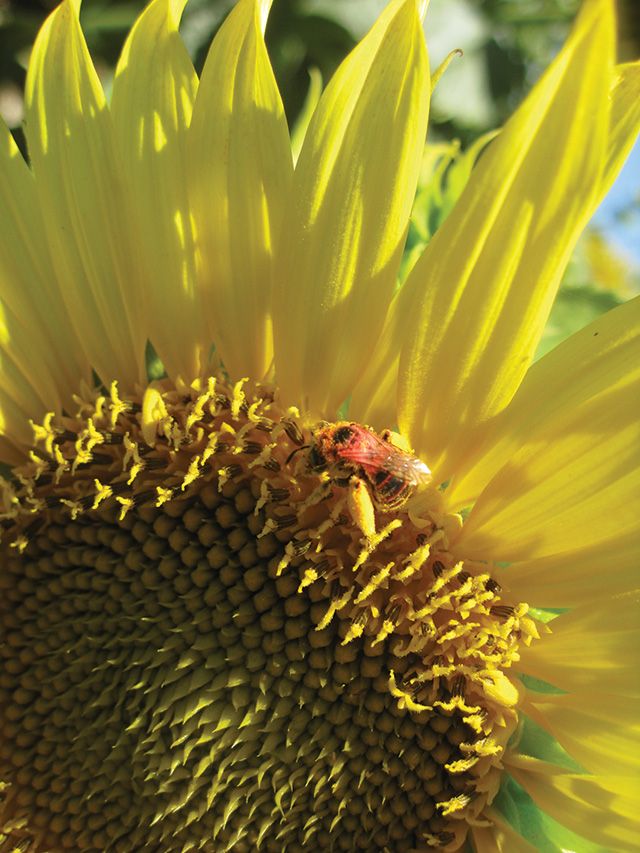
I point my bug vacuum at a bee foraging on a sunflower and press the trigger. With a soft whirr it plucks the unsuspecting bee from the bloom, trapping it in the shaft. I upend the bug vac—a children’s toy designed to suck up insects—and carefully tap the bee into a jar filled with sticky fluorescent powder. When the bee hits the dye it begins to buzz frantically. Its vibrations create a fine cloud that coats it from antennae to stinger. Once it is covered evenly, I release the bee, now bright pink, back into the field. Marking bees in this way allows me to return at night and sweep the field with a black light for traces of the powder left on the sunflowers by the bees—signs of activity that hint at their foraging behavior. This information is key to understanding whether native bees contribute to sunflower seed production, and ultimately whether wild bees are capable of fully pollinating important agricultural crops.
Sunflowers are visited by a community of bee species that look and act similarly. Collectively, scientists call them “sunflower bees.” Female sunflower bees are at least as big as honeybees and are covered with dense, straw-colored hair. Long orange antennae protrude from the heads of male sunflower bees like ram antlers. Instead of foraging for pollen on the sunflowers, males tear up and down rows searching for females. They aren’t very discerning, often attempting to mate with any bee they find on a sunflower, regardless of sex or species. They land on their potential lovers’ backs, which usually leads their targets to hurl themselves from the flowers. The two entwined bees plummet toward the ground until one struggles free and buzzes to a different bloom. Such frenzied mating activities increase the amount of pollen moving between different sunflower plants, contributing to higher seed yields. But they also make male sunflower bees nearly impossible to catch—a fact that doesn’t stop me from trying.
The sunflower, Helianthus annuus, is indigenous to North America, where it still grows wild. However, it is now more common to see vast stretches of yellow along highways in agricultural regions such as California’s Central Valley, where massive fields are grown for sunflower oil and seed. Sunflow
 Female sunflower bee (Melissodes sp.) marked with pink fluorescent powder.
Female sunflower bee (Melissodes sp.) marked with pink fluorescent powder.
ers rely on pollination from bees to form their seeds. A vast field therefore requires an army of bees. While honeybees are easily transportable, they are in short supply due to a multitude of diseases that wreak havoc on hives. This scarcity has driven up the rental costs of honeybee colonies, forcing farmers to search for alternative pollinators to supplement honeybees. Fortunately, wild sunflower bees also pollinate agricultural varietals. If I can show that they contribute substantially to sunflower pollination, then perhaps I can convince farmers to create habitats for sunflower bees on their farms, helping them reduce their reliance on the now vulnerable honeybee.
By mid-morning, the sunflower field erupts into a riot of activity, with bees zipping by, unintentionally cross-pollinating. Morning is the best time to catch; as the sun rises overhead, activity begins to wane as the bees seek refuge in their underground nests, and my capture rate plummets. I desperately scan the flowers as I try to beat the pervasive heat. Before long, evaporating irrigation water creates conditions not unlike a sauna. Columns of heat shimmer upwards, only to be trapped beneath the arching canopy of sunflowers that rises over my head. Humidity is so high that I cry tears of sweat. The bees become more and more scarce. In each field I try to mark 100 bees. I blink away the salty droplets and focus on the task at hand.
Finally, I see a female bee hovering over the ground, flying back and forth laterally. This sort of behavior indicates that she might be nesting nearby, but might not remember which clump of soil indicates her nest entrance. I stand still, so as not to scare her, and watch intently. Eventually she descends into a non-descript tunnel that from my angle looks more like a shadow than a nest.
 Sunflower under a black light at night. The pink fluorescent spot indicates that this flower was visited by at least one marked bee.
Sunflower under a black light at night. The pink fluorescent spot indicates that this flower was visited by at least one marked bee.
Female bees return to their nests dozens of times per day to deposit the pollen they’ve taken from flowers. Although the waxy frames of honeycomb are an enduring image of a honeybee hive, most bees, including sunflower bees, nest in holes they excavate in the ground. They buck conventional knowledge about bees living in colonies with worker bees and a queen bee: sunflower bees are solitary and lay their own young. Instead of making honey, they make “bee bread,” balls of pollen mixed with nectar, which they feed to their larvae. Some bees mark their nest entrances with excavated soil that rises in spatters like a drip sandcastle. Others initiate their nests in crevices such that the opening is not at ground level, making them nearly impossible to detect. Male bees do not make nests; at night they huddle together to keep warm, ringing the edges of flowers, near the petals, their mass of fuzz like a well-trimmed beard across a sunflower’s face.
Due to their body size, bees can fly only a certain distance from their nests, and can thus only pollinate plants found within that span, known as their foraging range. In addition to marking bees with fluorescent dye, I also look for nests. Nesting preference is one of the most poorly described areas of bee biology, and usually I am not lucky enough to have a bee inadvertently point out its nest to me. Instead I try to determine where bees nest by placing specially designed open-bottomed tents, called emergence traps, throughout fields. If a bee is nesting under the trap, when it leaves its nest it is captured in a jar at its apex. The information I compile about nesting enhances my interpretation of the dye marks the bees leave in the fields. If sunflower bees only nest in certain locations, they may forage closer to their nests, creating uneven yield patterns across a field, whereas if they can nest everywhere, I’d expect them to boost yields evenly throughout the field.
Eventually, I’m satisfied I have marked enough bees to have a fruitful night searching for traces of dye on flowers. Different fields have varying numbers of sunflower bees that are drawn in from the surrounding landscape. I never know how successful I’ll be until I’ve already spent hours vacuuming bees from flowers. But for now, all I can do is search for some shade where I can wait until nightfall. Then, when the powder is most visible under black lights, I will head back out into the field.
Evening is a welcome time of day: as the heat diminishes with the setting sun, I venture back into the field, emergence traps in hand. I lay the traps over patches of bare ground to catch bees emerging from their nests in the morning. Setting the traps at dusk ensures bees have returned to their nests. I’ll check the emergence traps tomorrow, removing all the bees that were unlucky enough to nest in a location over which I’ve randomly set a trap.
Once darkness falls, I walk along each row slowly, shining the steady purple beam from my black light on every flower head, alert for hints of fluorescence. As I scan, a faint green glow emanates from the huge sunflower heads, residues of their nectar, which also fluoresce under UV light. Then, out of nowhere, there is a flash of bright neon pink. I draw the black light closer, studying the amount of dye and recording its location on the flower. The pink specks, evidence of bee visitation, are abundant in the row where bees were marked, but quickly decline in intensity, despite findings by other researchers that the dye can stay on bees for up to 20 visits. This indicates that bees may not move very far, at least not when presented with thousands of sunflower blooms in close proximity.
Retreading the areas I walked earlier in the day, I notice different insects visiting the flowers, including moths. Then my light catches something dark, blocking the faint gleam from the nectar. Upon closer inspection I discover a mass of sleeping male bees. Whereas earlier they moved so quickly they blurred, now they are still. Males don’t have stingers, which are modified ovipositors that females use to lay eggs. This lack of defense means I can pluck them up without fear of reprisal other than angry, harmless buzzing. I snatch one up and pinch him between my fingers. He slowly wakes and tries in vain to struggle free, buzzing constantly. As I concentrate on his intensifying vibration, the morning’s insufferable heat is all but forgotten.
This article is part of the Spring 2013 issue.



